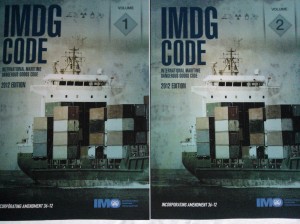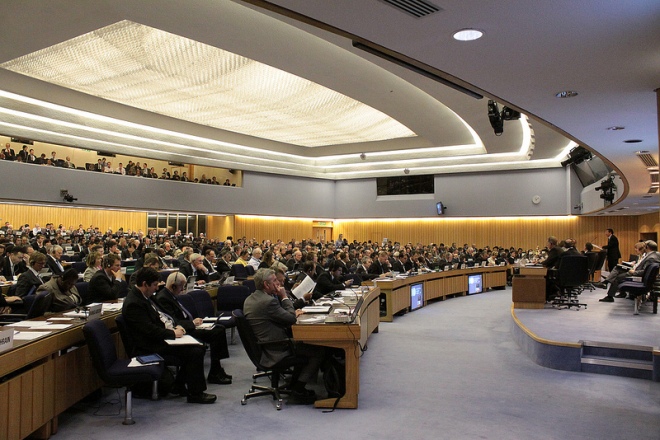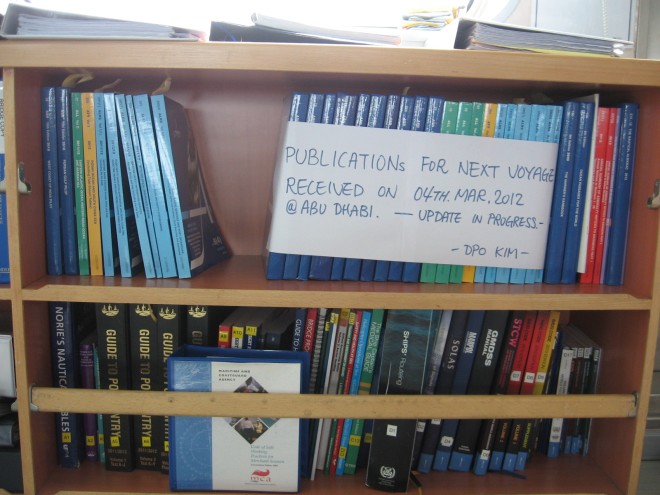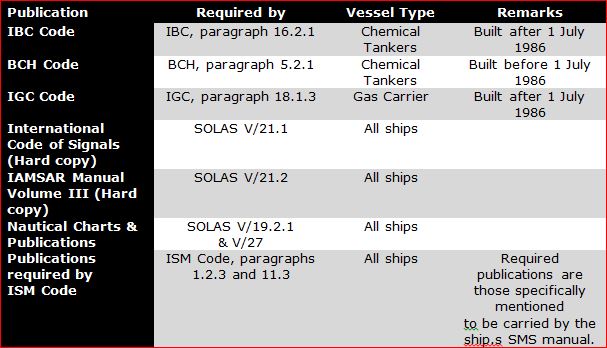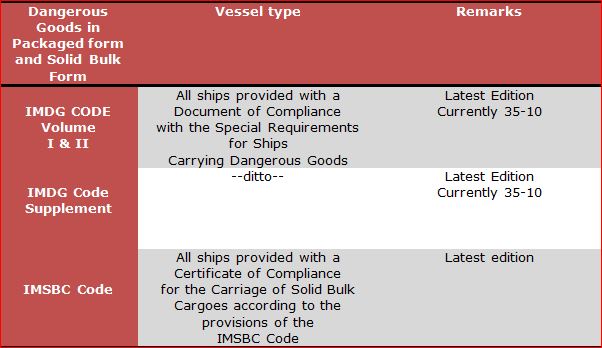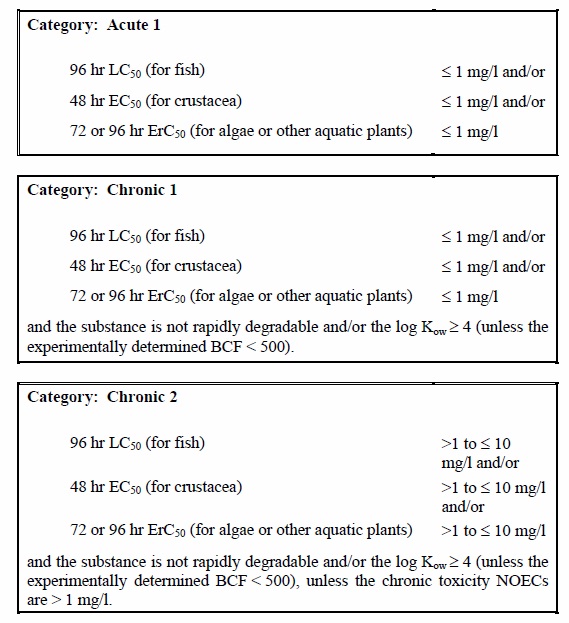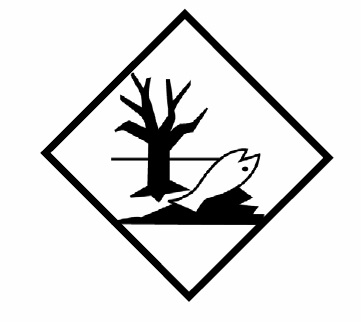| ALGERIA |
Ministère des Transports/Direction de la Marine Marchande119 Rue Didouche MouradAlgerALGÉRIE
Telephone: +213 260 61 46
Telex: 66063 DGAF DZ |
| AMERICANSAMOA |
Silila PataneHarbourmasterPort AdministrationPago Pago
AMERICAN SAMOA 96799 |
| ANGOLA |
National DirectorMarine Safety, Shipping and PortsNational Directorate of Merchant Marine and PortsRua Rainha Ginga 74
Andar, Luanda
Angola
Telephone: +244 239 0034/39 7984
Telefax: +244 231 037
Mobile: +244 924 39 336
E-mail: ispscode_angola@snet.co.ao |
| ARGENTINA |
Prefectura Naval Argentina(Argentine Coast Guard)Dirección de Protección ambientalDepartamento de protección ambiental y mercancías peligrosas
Division mercancías y residuos peligrosos
Avda. Eduardo Madero 235
4o piso, Oficina 4.36 y 4.37
Buenos Aires (C1106ACC)
REPÚBLICA ARGENTINA
Telephone: +54 11 4318 7669
Telefax: +54 11 4318 7474
E-mail: dpma-mp@prefecturanaval.gov.ar |
| AUSTRALIA |
Manager – Ship Inspection GroupAustralian Maritime Safety AuthorityGPO Box 2181Canberra ACT 2601
AUSTRALIA
Telephone: +61 2 6279 5048
Telefax: +61 2 6279 5058
E-mail: psc@amsa.gov.au
Website: www.amsa.gov.au |
| BAHAMAS |
Bahamas Maritime Authority120 Old Broad StreetLondon, EC2N 1 ARUNITED KINGDOM
Telephone: +44 20 7562 1300
Telefax: +44 20 7614 0650
E-mail: tech@bahamasmaritime.com |
| BANGLADESH |
Department of Shipping141-143, Motijheel Commercial AreaBIWTA Bhaban (8th Floor)Dhaka-1000
Bangladesh
Telephone: +880 2 9555128
Telefax: +880 2 7168363
E-mail: dosdgdbd@bttb.net.bd |
| BARBADOS |
Director of Maritime AffairsMinistry of Tourism and International Transport2nd Floor Carlisle HouseHincks Street
Bridgetown
St. Michael
BARBADOS
Telephone: +1 246 426 2710/3342
Telefax: +1 246 426 7882
E-mail: ctech@sunbeach.net |
| BELGIUM |
Brussels Office Federal Public Service Mobility and TransportDirectorate-General Maritime Transport
Rue du Progrès 56
B-1210 Brussels
BELGIUM
Telephone: +32 2 277 3500
Telefax: +32 2 277 4051
E-mail: dg.mar@mobilit.fgov.be
Website: www.mobilit.fgov.be
Antwerp Office
Federale Overheidsdienst Mobiliteit en Vervoer
Directoraat-generaal Maritiem Vervoer
Scheepvaartcontrole
Loodsgebouw
Tavernierkaai 3
B-2000 Antwerpen
BELGIUM
Telephone: +32 3 229 0030
Telefax: +32 3 229 0031
E-mail: hazmat.antwerpen@mobilit.fgov.be
Ostend Office
Federale Overheidsdienst Mobiliteit en Vervoer
Directoraat-generaal Maritiem Vervoer
Scheepvaartcontrole
Natiënkaai 5
B-8400 Oostende
BELGIUM
Telephone: +32 59 56 1450
Telefax: +32 59 56 1474
E-mail: hazmat.zeebrugge@mobilit.fgov.be
|
| BELIZE |
Ports CommissionerBelize Port AuthorityPO Box 633Belize City
BELIZE C.A.
Telephone: +501 227 2540/0981
Telefax: +501 227 2500 |
| BRAZIL |
Diretoria de Portos e Costas (DPC-20)Rua Teófilo Otoni No. 04CentroRio de Janeiro
CEP 20090-070
BRAZIL
Telephone: +55 21 2104 5203
Telefax: +55 21 2104 5202
E-mail: secom@dpc.mar.mil.br |
| BULGARIA |
Head office:Captain Petar Petrov, DirectorDirectorate “Quality Management”Bulgarian Maritime Administration
9 Dyakon Ignatii Str.
Sofia 1000
REPUBLIC OF BULGARIA
Telephone: +359 2 93 00 910 / 93 00 912
Telefax: +359 2 93 00 920
E-mail: bma@marad.bg / petrov@marad.bg
Regional offices:
Harbour-Master
Directorate
“Maritime Administration” – Bourgas
3 “Kniaz Alexander Batemberg” Str.
Bourgas 8000
REPUBLIC OF BULGARIA
Telephone: +359 56 875 775
Fax: +359 56 840 064
E-mail: hm_bs@marad.bg
Harbour-Master
Directorate
“Maritime Administration” – Varna
5 “Primorski” Bvd
Varna 9000
REPUBLIC OF BULGARIA
Telephone: +359 52 684 922
Fax: +359 52 602 378
E-mail: hm_vn@marad.bg |
| BURUNDI |
MinisterMinistère des Transports Postes et TélécommunicationsBP 2000Bujumbura
Burundi
Telephone: +257 219 324
Telefax: +257 217 773 |
| CANADA |
The ChairmanMarine Technical Review BoardContact: Director, Operations & Environmental ProgramsMarine Safety, Transport Canada
Tower C, Place de Ville
330 Sparks Street, 10th Floor
Ottawa, Ontario K1A 0N5
CANADA
Telephone: +1 613 991 3132
+1 613 991 3143
+1 613 991 3139/40
Telefax: +1 613 993 8196
Packaging approvals
Director Regulatory Affairs
Transport Dangerous Goods Directorate
Tower C, Place de Ville
330 Sparks Street, 9th Floor
Ottawa, Ontario K1A 0N5
CANADA
Telephone: +1 613 998 0519
+1 613 990 1163
+1 613 993 5266
Telefax: +1 613 993 5925 |
| CAPE VERDE |
The Director GeneralMinistry of Infrastructure and TransportsSt. VincenteCAPE VERDE
Telephone: +238 2 328 199
+238 2 585 4643
E-mail: dgmp@cvtelecom.cv |
| CHILE |
Dirección General del Territorio Marítimo y de Marina MercanteDirección de Seguridad y Operaciones MarítimasServicio de Inspecciones MarítimasDivisón Prevención de Riesgos y Cargas Peligrosas
Subida Cementerio No.300
Valparaíso
CHILE
Telephone: +56 32 220 8699
+56 32 220 8654
+56 32 220 8692 |
| CHINA |
Maritime Safety AdministrationPeople’s Republic of China11 Jianguomen Nei AvenueBeijing 100736
CHINA
Telephone: +86 10 6529 2588
+86 10 6529 2218
Telefax: +86 10 6529 2245
Telex: 222258 CMSAR CN |
| COMOROS |
Ministre D’EtatMinistère du Développement des Infrastructures des Postes et desTélécommunication et des TransportInternationaux
Moroni
Union des Comores
Telephone: +269 744 287/735 794
Fax: +269 734 241/834 241
Mobile: +269 340 248
E-mail: houmedms@yahoo.fr |
| CROATIA |
Ministry of Maritime AffairsTransport and CommunicationMarine Safety DivisionPrisavlje 14
1000 Zagreb
REPUBLIC OF CROATIA
Telephone: +385 1 611 5966
Telefax: +385 1 611 5968
E-mail: pomorski-promet@zg.tel.hr
Testing and certification of packagings
Adriainspekt
Ciottina 17/b
51000 Rijeka
REPUBLIC OF CROATIA
Telephone: +385 51 511 133
Telefax: +385 51 36 176
Classification society for CSC containers (including IMO tanks)
Croatian Register of Shipping
Marasoviceva 67
21000 Split
REPUBLIC OF CROATIA
Telephone: +385 21 358 933
Telefax: +385 21 358 159 |
| CUBA |
Ministerio del TransporteDirección de Seguridad e Inspección MarítimaBoyeros y Tulipán PlazaCiudad de la Habana
CUBA
Telephone: +537 8816 607
+537 8819 498
Telefax: +537 8811 514
E-mail: dsim@mitrans.transnet.cu |
| CYPRUS |
Department of Merchant ShippingMinistry of Communications and WorksKylinis StreetMesa Geitonia
CY-4007 Lemesos
P.O. Box 56193
CY-3305 Lemesos
CYPRUS
Telephone: +357 5 848 100
Telefax: +357 5 848 200
Telex: 2004 MERSHIP CY
E-mail: dms@cytanet.com.cy |
| CZECHREPUBLIC |
ImplementationMinistry of Transport of the Czech RepublicNavigation and Waterways DivisionNábr. L. Svobody 12
110 15 Praha 1
CZECH REPUBLIC
Telephone: +42 2 230 312 25
Telefax: +42 2 248 105 96
Telex: +42 2 12 10 96 Domi C
Packaging, Testing and Certification Institutes
CIMTO, s.p.
Un Michelského lesa 336
146 23 Praha 4
CZECH REPUBLIC
Telephone: +42 2 472 94 64
Telefax: +42 2 472 36 76
IMET, s.r.o.
Bažantni 697
165 00 Praha 6
CZECH REPUBLIC
Telephone: +42 2 39 32 96
Telefax: +42 2 29 23 70
Classification of dangerous goods of all classes, except class 7 – radioactive materials
Český lodní a prumysloý registr, s.r.o.
(Czech Shipping and Industry Register, Ltd.)
Jankovcova 10
170 00 Praha 7
CZECH REPUBLIC
Telephone: +42 2 667 10001
Telefax: +42 2 808 984
Telex: +42 2 122 874 csir c |
| DENMARK |
Danish Maritime AuthorityP.O. Box 2605Vermundsgade 38C2100 Copenhagen Ø
DENMARK
Telephone: +45 39 17 44 00
Telefax: +45 39 17 44 01
E-mail: SFS@dma.dk
Packing, Testing and Certification Institute
Emballage og Transportinstituttet (E.T.I.)
Dansk Teknologisk Institut
Gregersensvej
2630 Tåstrup
DENMARK
Packagings in conformity with the IMDG Code will be marked “DK Eti” |
| DJIBOUTI |
Director of Maritime AffairsMinistère de L’Equipement et des TransportsP.O. Box 59Djibouti
Telephone: +253 357 913
Fax: +253 351 538/253 931/355 879 |
| ECUADOR |
Dirección General de la Marina Mercante y del LitoralP.O. Box 7412GuayaquilECUADOR
Telephone: +593 4 526 760
Telefax: +593 4 324 246
Telex: 04 3325 DIGMER ED |
| EQUATORIALGUINEA |
The Director General (Maritime Affairs)Ministro de Transportes, Technologia, Correos y TelecommunicacionesMalaboRep. de GUINEA ECUATORIAL
Telephone: +240 275 406
Fax: +240 092 618 |
| ERITREA |
Director GeneralDepartment of Maritime TransportMinistry of Transport and CommunicationsEritrea
Telephone: +291 1 121 317/189 156/185 251
Fax: +291 1 184 690 / 186 541
E-mail: motcrez@eol.com.er |
| ESTONIA |
Estonian Maritime AdministrationMaritime Safety DivisionValge 4EST-11413 Tallinn
ESTONIA
Telephone: +372 6205 700/715
Telefax: +372 6205 706
E-mail: mot@vta.ee |
| ETHIOPIA |
Maritime Affairs AuthorityP.O Box 1B61, Addis AbabaEthiopiaTelephone: +251 1 011 5 503683/38
Fax: +251 1 011 5 503960
Mobile: +251 1 0911513973
E-mail: maritime@ethione.et |
| FIJI |
The Director of Maritime SafetyFiji Islands Maritime Safety AdministrationGPO Box 326Suva
FIJI
Telephone: +679 331 5266
Telefax : +679 330 3251
E-mail : fimsa@connect.com.fj |
| FINLAND |
Finnish Maritime AdministrationP.O. Box 171FI-00181 HelsinkiFINLAND
Telephone: +358 20 448 1
Telefax: +358 20 448 4500
+358 20 448 4336
E-mail: kirijaamo@fma.fi
Packaging and Certification Institute
Safety Technology Authority (TUKES)
P.O. Box 123
FI-00181 Helsinki
FINLAND
Telephone: +358 96 1671
Telefax: +358 96 1674 66
E-mail: kirjaamo@tukes.fi |
| FRANCE |
MTETM/DGMT/MMDArche sud92055 La Défense CedexFRANCE
Telephone: +33 (0)1 40 81 86 49
Telefax: +33 (0)1 40 81 10 65
E-mail: olga.lefevre@equipement.gouv.fr
Organizations authorized to carry out testing and type approval of packaging
1 Bureau de Vérifications Techniques (BVT)
ZAC de la Cerisaie
31, rue de Montjean
94266 FRESNES Cedex
FRANCE
2 Laboratoire d’études et de recherche
des emballages métalliques (LEREM)
3, rue Fernand Hainaut
93400 SAINT-OUEN
France
3 Laboratoire National d’Essais (LNE)
Laboratoire de Trappes
5, avenue Enrico Fermi
78197 TRAPPES Cedex
FRANCE
4 CEREM-LNE Sud
190, rue Georges Besse
30035 NIMES Cedex 1
FRANCE
Organizations authorized to carry out checks of mass-produced
packagings
1 Bureau de Vérifications Techniques (BVT)
2 Laboratoire d’études et de recherche des
emballages métalliques (LEREM)
3 Laboratoire National d’Essais (LNE)
4 Bureau Veritas (BV)
The BVT, the LNE and the BV are each authorized to carry out checks of mass-produced IBCs, within their respective areas of authority.
Organizations authorized to carry out testing and initial and periodic
inspections of metal and rigid plastics IBCs and of composite IBCs with
plastic inner receptacles
1 Bureau de Vérifications Techniques (BVT)
2 Laboratoire National d’Essais (LNE)
3 Bureau Veritas (BV)
4 Groupement des Associations de Propriétaires d’Appareils à Vapeur et
Electriques (GAPAVE)
Organizations authorized for the approval of tanks
1 American Bureau of Shipping (ABS)
2 Bureau Veritas (BV)
3 Lloyd’s Register of Shipping (LR)
4 Groupement des Associations de Propriétaires d’Appareils à Vapeur et
Eléctriques (GAPAVE)* |
| GAMBIA |
The Director GeneralGambia Port AuthorityP.O. Box 617Banjul
THE GAMBIA
Telephone: +220 4 227 270
+220 4 227 260
+220 4 227 266
Fax: +220 4 227 268 |
| GERMANY |
Federal Ministry of Transport, Building and Urban AffairsDivision A 33 – Transport of Dangerous GoodsPO Box 20 01 00D-53170 Bonn
GERMANY
Telephone: +49 228 3000 or 300-extension
+49 228 300 2643
Telefax: +49 228 300 3428
E-mail: Ref-A33@bmvbs.bund.de
Packing, Testing and Certification Institute:
Federal Institute for Materials Research and Testing
(Bundesanstalt fur Materialforschung und -prüfung (BAM))
Unter den Eichen 87
D-12205 Berlin
GERMANY
Telephone: +49 30 8104 0 or extension
+49 30 8104 1310
+49 30 8104 3407
Telefax: +49 30 8104 1227
E-mail: ingo.doering@bam.de
Packagings, IBCs, and multimodal tank-containers in conformity with the
IMDG Code will be marked as specified in section 6 of annex I to the Code (references are to Amendment 29). The markings in accordance
with 6.2(f) will be “D/BAM” |
| GHANA |
The Director GeneralGhana Maritime AuthorityPMB. 34, Ministries Post OfficeMinistries – Accra
GHANA
Telephone: +233 21 662 122 / 684 392
Fax: +233 21 677 702
E-mail: info@ghanamaritime.org |
| GREECE |
Ministry of Mercantile MarineSafety of Navigation DivisionInternational Relations Department150 Gr. Lambraki Av.
185 18 Piraeus
GREECE
Telephone: +301 41 91188
Telefax: +301 41 28150
Telex: +212022, 212239 YEN GR
E-mail: dan@yen.gr |
| GUINEA BISSAU |
The MinisterMinistry of Transport & CommunicationAv.3 de AgostoBissau
GUINEA BISSAU
Telephone: +245 212 583
+245 211 308 |
| GUYANA |
Guyana Maritime Authority/AdministrationMinistry of Public Works and Communications BuildingTop FloorFort Street
Kingston
Georgetown
REPUBLIC OF GUYANA
Telephone: +592 226 3356
+592 225 7330
+592 226 7842
Telefax: +592 226 9581
E-mail: MARAD@networksgy.com |
| ICELAND |
Iceland Maritime AdministrationVerturvör 2IS-202 KópavogurICELAND
Telephone: +354 560 0000
Telefax: +354 560 0060
E-mail: skrifstofa@vh.is
Directorate of Shipping
Hringbraut 121
P.O. Box 7200
127 Reykjavik
ICELAND
Telephone: +354 1 25844
Telefax: +354 1 29835
Telex: 2307 ISINFO |
| INDIA |
The Directorate-General of ShippingJahz BhawanWalchand Hirachand MargBombay 400 001
INDIA
Telephone: +91 22 263651
Telex: DEGESHIP 2813-BOMBAY
Packaging, Testing and Certification Institute
Indian Institute of Packaging
Bombay
Madras
Calcutta
INDIA |
| INDONESIA |
Director of Marine SafetyDirectorate-General Sea Communication(Department Perhubungan)JI. Merdeka Barat No. 8
Jakarta Pusat
INDONESIA
Telephone: +62 381 3269
Telefax: +62 384 0788 |
| IRAN |
M. SadeghifarDirector General of Port AffairsPorts and Shipping OrganizationPSO Building
South Didar Ave
Shahid Haghani Highway
Vanak Square
Tehran
IRAN
Telephone: +98 21 849 32201
Telefax: +98 21 849 32227 |
| IRELAND |
The Chief SurveyorMarine Survey OfficeDepartment of TransportLeeson Lane
Dublin 2
IRELAND
Telephone: +353 1 604 14 20
Telefax: +353 1 604 14 08
E-mail: mso@transport.ie |
| ISRAEL |
Shipping and Ports InspectorateItzhak Rabin GovernmentComplex Building 2Pal-Yam 15a
Haifa 31999
ISRAEL
Telephone: +972 4 8632080
Telefax: +972 4 8632118
E-mail: techni@mot.gov.il |
| ITALY |
Italian Coast Guard HeadquartersPonte Dei MilleGenoa16100
ITALY
Telephone: +39 010 25 18 154 + 102
+39 010 25 18 154 + 111
Fax: +39 010 24 78 245
E-mail: 001@sicnavge.it
005@sicnavge.it |
| JAMAICA |
The Maritime Authority of Jamaica4th Floor, Dyoll Building40 Knutsford BoulevardKingston 5
JAMAICA, W.I.
Telephone: +1 876 929 2201
+1 876 754 7260/5
Telex: +1 876 7256
E-mail: maj@jamaicaships.com
Website: www.jamaicaships.com
Testing and certifying authority
The Bureau of Standards
6 Winchester Road
P.O. Box 113
Kingston
JAMAICA
Telephone: +1 809 92 63140 7
Telex: 2291 STANBUR Jamaica
Cable: STANBUREAU |
| JAPAN |
Inspection and Measurement DivisionMaritime BureauMinistry of Land, Infrastructure and Transport2-1-3 Kasumigaseki, Chiyoda-ku
Tokyo
JAPAN
Telephone: +81 3 5253 8639
Telefax: +81 3 5253 1644
E-mail: MRB_KSK@mlit.go.jp
Nippon Hakuyohin Kentei Kyokai (HK)
(The Ship Equipment Inspection Society of Japan)
3-32, Kioi-Cho, Chiyoda-ku
Tokyo
JAPAN
Telephone: +81 3 3261 6611
Telefax: +81 3 3261 6979
Packagings, IBCs and large packagings in conformity with the IMDG Code
will be marked “J”, “J/JG” or “J/HK”. |
| KENYA |
Director GeneralKenya Maritime AuthorityP.O. Box 95076 (80104)Mombasa
Kenya
Telephone: +254 041 231 8398/9
Telefax: +254 041 231 8397
E-mail: nkarigithu@yahoo.co.uk
info@maritimeauthority.co.ke
karigithu@ikenya.com
Ministry of Transport & Communications
P.O. Box 52692
Nairobi
Telephone: +254 020 272 9200
Telefax: +254 020 272 4553
E-mail: motc@insightkenya.com
Peterhuo_2004@yahoo.com |
| LATVIA |
Maritime Administration of LatviaMaritime Safety DepartmentTrijadibas iela 5,LV-1048Riga
LATVIA
Telephone: +371 670 62 171
+371 670 62 120
Telefax: +371 678 60 083
E-mail: Janis.sticenko@lja.lv
Website: www.jurasadministracija.lv
Classification Societies
American Bureau of Shipping
Bureau Veritas
Det Norske Veritas
Lloyd’s Register of Shipping
Russian Maritime Register of Shipping |
| LIBERIA |
Commissioner/AdministrationBureau of Maritime AffairsP.O. Box 10-90421000 Monrovia 10
Monrovia
LIBERIA
Telephone: +231 227 744 / 37747 / 510 201
Fax: +231 226 069
E-mail: maritime@liberia.net
Testing and certification
American Bureau of Shipping
Bureau Veritas
China Classification Society
Det Norske Veritas
Germanischer Lloyd
Korean Register of Shipping
Lloyd’s Register of Shipping
Nippon Kaiji Kyokai
Polski Rejestr Statkow
Registro Italiano Navale
Russian Maritime Register of Shipping |
| LITHUANIA |
ImplementationMinistry of Transport and CommunicationsWater Transport DepartmentGedimino Av. 17, 01505 Vilnius,
Lithuania
Telephone: +370 5 239 3986
Telefax: +370 5 212 4335
E-mail: d.krivickiene@transp.lt
Inspection
Lithuanian Maritime Safety Administration
J. Janonio str.24
92251 Klaipeda
Lithuania
Telephone: +370 46 469 662
Telefax: +370 46 469 600
E-mail: alvydas.nikolajus@msa.lt |
| MADAGASCAR |
DirectorAgence Portuaire Maritime et Fluviale (APMF)P.O. Box 581Antananarivo – 101
Madagascar
Telephone/Fax: +261 20 222 5860
Telephone: +261 20 242 5701
Mobile: +261 320 229 259
E-mail: spapmf.dt@mttpat.gov.mg |
| MALAWI |
Director of Marine ServicesMarine DepartmentMinistry of Transport & Civil AviationPrivate Bag A81
Capital City Lilongwe
Malawi
Telephone: +265 1 755 546/752 666 /753 531 DL
Fax: +265 1 750 157/758 894
E-mail: marinedepartment@malawi.net
marinesafety@africa-online.net |
| MALAYSIA |
DirectorMarine Department, Peninsular MalaysiaP.O. Box 1242009 Port Kelang
Selangor
MALAYSIA
Telex: MA 39748
Director
Marine Department, Sabah
P.O. Box 5
87007 Labuan
Sabah
MALAYSIA
Director
Marine Department, Sarawak
P.O. Box 530
93619 Kuching
Sarawak
MALAYSIA |
| MARSHALLISLANDS |
Office of the Maritime AdministratorMaritime Operations DepartmentRepublic of the Marshall Islands11495 Commerce Park Drive
Reston, Virginia 20191-1507
USA
Telephone: +1 703 620 4880
Telefax: +1 703 476 8522
Telex: 248403 IRI UR
E-mail: maritime@register-iri.com |
| MAURITIUS |
Director of ShippingMinistry of Land Transport Shipping and Public SafetyNew Govt. Centre 4 FloorPort Louis
MAURITIUS
Telephone: +230 201 2115
Mobile: +230 774 0764
Fax: +230 211 7699/216 1612/201 3417
E-mail: pseebaluck@mail.gov.mu |
| MEXICO |
Stowage, segregation, labelling and documentation of goodsCoordinación General de Puertos y Marina MercanteSecretaría de Comunicaciones y TransportesAvenida Nuevo León no. 210, Piso 19
Colonia Hipódromo Condesa, C.P. 06100
México, Distrito Federal
MÉXICO
Telephone: +52 55 5265 3110
Telefax: +52 55 5265 3108
E-mail: achacon@sct.gob.mx
Coordinador General: Lic. Alejandro Chacón Dominguez
Receipt and processing of notifications in the event of a package falling
overboard
Secretaría de Marina
Eje 2 Oriente, tramo Heroica Escuela Naval Militar no. 861
Colonia Los Cipreses, C.P. 04830
MÉXICO, D.F.
Telephone: +52 55 56 24 65 00
E-mail: subsrio@semar.gob.mx
Subsecretario de Marina: Almirante C.G. DEM Raúl Santos Galvan
Laboratory testing of packagings containing dangerous goods
Dirección General de la Sociedad Mexicana de Normalización
y Certificación S.C. (NORMEX)
Avenida San Antonio no.256, Piso 7
Colonia Ampliación Nápoles, C.P. 03849
MEXICO
Telephone: +52 55 5598 3036
Fax: +52 55 5598 5899
E-mail: normex@normex.com.mx
Director General: Dr. Jaime González Basurto |
| MONTENEGRO |
Ministry of Interior and Public Administrationof the Republic of MontenegroDepartment for Contingency Plans and Civil SecurityREPUBLIC OF MONTENEGRO
Telephone: +382 81 241 590
Fax: +382 81 246 779
E-mail: mup.emergency@cg.yu |
| MOROCCO |
Direction de la Marine Marchande et des Pêches MaritimesBoulevard El HansaliCasablancaMOROCCO
Telephone: +212 2 278 092
+212 2 221 931
Telex: 24613 MARIMAR M
22824 |
| MOZAMBIQUE |
General DirectorNational Maritime Authority (INAMAR)Marquês do Pombal Street No. 297P.O. Box 4317
Maputo
MOZAMBIQUE
Telephone: +258 21 320 552
Fax: +258 21 324 007
Mobile: +258 82 153 0280
E-mail: inamar@tvcabo.co.mz
General Director
National Maritime Authority (INAMAR)
Marquês do Pombal Street No. 297
P.O. Box 4317
Maputo
MOZAMBIQUE
Telephone: +258 21 320 552
Fax: +258 21 324 007
Mobile: +258 82 153 0280
E-mail: inamar@tvcabo.co.mz |
| NAMIBIA |
Director Maritime AffairsMinistry Works, Tranport and CommunicationPrivate Bag 133416719 Bell Street
Snyman Circle, Windhoek
NAMIBIA
Telephone: +264 61 208 8025/6
Direct Line: +264 61 208 8111
Fax: +264 61 240 024/224 060
Mobile: +264 811 220 599
E-mail: mmnangolo@mwtc.gov.na |
| NETHERLANDS |
Ministry of Transport, Public Works and Water ManagementDirectorate-General for Civil Aviation and Freight TransportUnit SafetyP.O. Box 20904
2500 EX The Hague
NETHERLANDS
Telephone: +31 70 351 1533/ 6171
Telefax: +31 70 351 1479
Ministry of Transport, Public Works and Water Management
Transport Information Centre
P.O. Box 90653
2509 LR The Hague
NETHERLANDS
Telephone: +31 70 456 2444
Telefax: +31 70 456 2424
E-mail: vervoerinfo@ivw.nl
Testing, marking and certification of packagings
TNO Certification BV
PTC Verpakking
Postbus 310
2300 AH Leiden
NETHERLANDS
Telephone: +31 71 535 17 10
Telefax: +31 71 535 17 17 |
| NEW ZEALAND |
Maritime New ZealandLevel 10 Optimation House1 Grey StreetPO Box 27-006
Wellington
NEW ZEALAND
Telephone: +64 4 473 0111
Telefax: +64 4 494 1263
E-mail: enquiries@maritimenz.govt.nz
Website: http://www.maritimenz.govt.nz
The authorized organizations which have delegated authority from the
Director of Maritime Safety for the approval, inspection and testing of all
portable tanks, tank containers and freight containers are:
American Bureau of Shipping
Bureau Veritas
Det Norske Veritas
Germanischer Lloyd
Lloyd’s Register of Shipping |
| NIGERIA |
Nigerian Maritime Administration and Safety Agency (NIMASA)Marine House4 Burma RoadApapa
P.M.B. 12861, GPO, Marina Lagos
NIGERIA
Telephone: +234 587 2214 / 580 4800/9
Fax: +234 587 1329
Telex: 23891, NAMARING
Website: www.nimasa.gov.ng |
| NORWAY |
Norwegian Maritime DirectorateSmedasundeh 50thN-5528 HAGESUNDNORWAY
Telephone: +47 5274 5000
Fax: +47 5244 5001
E-mail: postmottak@sjofartsdir.no
Certification of Packaging and IBCs:
Det Norske Veritas AS
Veritasveien 1
N-1322 Høvik
NORWAY
Telephone: +47 67 57 99 00
Telefax: +47 67 57 99 11
E-mail: TNCNO754@dvn.com
Certification of CSC containers:
Det Norske Veritas AS
Veritasveien 1
N-1322 Høvik
NORWAY
Telephone: +47 67 57 99 00
Telefax: +47 67 57 99 11
E-mail: mptno876@dnv.com
Lloyd’s Register EMEA
P.O. Box 1562 Vika
N-0253 Oslo
NORWAY
Telephone: +47 23 23 92 70
Telefax: +47 23 23 92 71
E-mail: oslo@lr.org
Certification of IMO Tanks:
Det Norske Véritas AS
Veritasveien 1
N-1322 Høvik
NORWAY
Telephone: +47 67 57 99 00
Telefax: +47 67 57 99 11
E-mail: mptno876@dnv.com |
| PAKISTAN |
Mercantile Marine Department70/4 Timber HardN.M. ReclamationKeamari, Post Box No.4534
Karachi 75620
PAKISTAN
Telephone: +92 21 2851 306
+92 21 2851 307
Telefax: +92 21 4547 472 (24 hours)
+92 21 4547 897
Telex: 29822 DGPS PK (24 hours) |
| PANAMA |
Autoridad Marítima de PanamáEdificio 5534, Diablo HeightsPO Box 0816 01548Panamá
PANAMA
Telephone: +507 501 5000
Telefax: +507 501 5007
E-mail: ampadmon@amp.gob.pa
Website: www.amp.gob.pa |
| PAPUA NEWGUINEA |
First Assistant SecretaryDepartment of TransportDivision of MarineP.O. Box 457
Konedobu
PAPUA NEW GUINEA (PNG)
Telephone: +675 211866
Telex: 22203 |
| PERU |
Dirección General de Capitanías y GuardacostasMarina de Guerra de PerúJr. Constitución No.150Callao
PERU
Telephone: +51 1 613 6857
Fax: +51 1 613 6857 / 6726
Telex: 26042 PE COSTCAL
E-mail: dicapi.medioambiente@dicapi.mil.peru
Dirección General de Capitanías y Guardacostas
Comandancia de Operaciones Guardacostas
Constitució 150, Callao, Perú
Telephone: +51 1 4291547/
+51 1 4200766/
+51 1 4202020
Fax: +51 1 4291547
E-mail: pemcc@dicapi.mil.pe /
comoperguard@dicapi.mil.pe
Dirección General de Capitanías y Guardacostas
Costera Paita
Paita, PERU
Telephone: +51 1 73 211670
Fax: +51 1 73 211670
E-mail: costera.paita@dicapi.mil.pe
MMSI: 007600121
Radio Call Sign: OBY2
Lenguaje entendido: Español / ingles
Direcció General de Capitanías y Guardacostas
Costera Callao
Callao, Perú
Telephone: +51 1 4299798 / +51 1 4200177
Fax: +51 1 4299798
E-mail: costera.callao@dicapi.mil.pe
MMSI: 007600125
Radio Call Sign: OB3
Lenguaje entendido: Español / ingles
Constitución 150, Callao
Telephone: +51 1 6136868 anexo 6671 / anexo 6752
Fax: +51 1 6136856 / +51 1 41219 |
| PHILIPPINES |
Philippine Ports AuthorityPort of ManilaSafety StaffP.O. 193, Port Area
Manila, 2803
PHILIPPINES
Telephone: +63 2 47 34 41 to 49 |
| POLAND |
Ministry of Maritime EconomyDepartment of Maritime Safety00-928 Warsawul. Chalubinskiego 4/6
POLAND
Telephone: +48 22 630 15 40
Telefax: +48 22 830 09 47
Packaging, Testing and Certification Institute
Centralny Ośrodek Badawczo-Rozwojowy
Opakowań
ul.Konstancińska 11
02-942 Warszawa
POLAND
Telephone: +48 22 42 20 11
Telefax: +48 22 42 23 03
Telex: 812473
Packagings in conformity with the IMDG Code will be marked “PL”
Classification societies
For CSC Containers
Polski Rejestr Statków (Polish Register of Shipping)
Al.Gen.J.Hallera 126
80-416 Gdańsk
POLAND
Telephone: +48 58 41 17 64
+48 58 46 03 82
+48 58 41 64 82
Telefax: +48 58 46 03 92
+48 58 46 13 96
Telex: 0512 952 PRS PL |
| PORTUGAL |
Direcção-Geral de Navegação e dos Transportes MarítimosPraça Luis de Camões, 22 – 2o Dto1200 LisboaPORTUGAL
Telephone: +351 1 373821
Telefax: +351 1 373826
Telex: 16753 SEMM PO |
| REPUBLIC OFKOREA |
Maritime Technology TeamMaritime Safety BureauMinistry of Maritime Affairs and Fisheries140-2 Gye-Dong, Jongno-gu, Seoul, 110-793
REPUBLIC OF KOREA
Telephone: +82 2 3674 6323
Telefax: +82 2 3674 6327 |
| RUSSIANFEDERATION |
Department of State Policy for Maritime and River TransportMinistry of Transport of the Russian FederationRozhdestvenka Street, 1, bldg. 1Moscow 109012
RUSSIAN FEDERATION
Telephone: +7 495 926 14 74
Classification society has been designated as competent inspector agency for the approval, acceptance and all consequential activities connected with IMO Type tanks, CSC containers, Intermediate Bulk Containers (IBCs) and packaging to be registered in the Russian Federation:
Russian Maritime Register of Shipping
Telephone: +78 123 128 878
+78 123 140 743
+78 123 141 087
Telex: 121525 RSSU RU
E-mail: pobox@rs-head.spb.ru
Ministry of Transport of the Russian Federation
Regulation of Maritime Transport Operation Department
1/4 Rozhdestvenka Street
Moscow 103759
RUSSIAN FEDERATION
Telephone: +7 095 151 3839
+7 095 151 3406
+7 095 151 3839
Telex: 411197 MMF RU
Packaging, testing and certification Institute
Central Marine Research and Design Institute (CNIIMF)
6. Kavalergardskaya Street
Saint Petersburg, 193015
RUSSIAN FEDERATION
Telephone: +7 812 275 89 47
Telefax: +7 812 274 38 64
Telex: 821483 CNIMF RU |
| SAINT KITTS ANDNEVIS |
Department of Maritime AffairsDirector of Maritime AffairsMinistry of TransportP.O. Box 186, Needsmust
ST. KITTS, W.I.
Tel: +869 466 7032/ 4846
Fax: +869 465 0604/ 9475
E-mail: Maritimeaffairs@yahoo.com
St. Kitts and Nevis
International Registrar of Shipping and Seamen
West Wing, York House
48-50 Western Road
Romford RM1 3LP
UNITED KINGDOM
Tel: +44 1708 380 400
Fax: +44 1708 380 401
E-mail: mail@stkittsregistry.net |
| SAO TOME &PRINCIPE |
The MinisterMinistry of Public Works, Infrastructure & Land PlanningC.P. 171SAO TOME & PRINCIPE
Telephone: +239 223 203
+239 226 368
Fax: +239 222 824 |
| SAUDI ARABIA |
Port Authority Saudi ArabiaCivil DefenceRiyadhSAUDI ARABIA
Telephone: +966 1 464 9477 |
| SEYCHELLES |
Director GeneralSeychelles Maritime Safety AdministrationP.O. Box 912Victoria, Mahe
SEYCHELLES
Telephone: +248 224 866
Fax: +248 224 829
E-mail: dg@msa.sc |
| SIERRA LEONE |
The Executive DirectorSierra Leone Maritime AdministrationMaritime HouseGovernment Wharf Ferry Terminal
P.O. Box 313
Freetown
SIERRA LEONE
Telephone: +232 22 221 211
Fax: +232 22 221 215
E-mail: slma@sierratel.sl
slmaoffice@yahoo.com |
| SINGAPORE |
Maritime and Port Authority of SingaporeShipping Division21st Storey PSA Building460 Alexandra Road
SINGAPORE
119963
Telephone: +65 375 1931/6223/1600
Telefax: +65 375 6231
E-mail: shipping@mpa.gov.sg |
| SLOVENIA |
Uprava Republike Siovenije za pomorstvoUkmarjev trg 266 000 KoperSLOVENIA
Telephone: +386 66 271 216
Telefax: +386 66 271 447
Telex: 34 235 UP POM SI |
| SOUTH AFRICA |
South African Maritime Safety AuthorityP.O. Box 13186Hatfield0028 Pretoria
SOUTH AFRICA
Telephone: +27 12 342 3049
Telefax: +27 12 342 3160
South African Maritime Safety Authority
Hatfield Gardens, Block E (Ground Floor)
Corner Arcadia and Grosvenor Street
Hatfield
0083 Pretoria
SOUTH AFRICA
Head Office Administration
Chief Director
Chief Directorate – Shipping
Department of Transport
Private Bag X193
0001 Pretoria
SOUTH AFRICA
Telephone: +27 12 290 2904
Telefax: +27 12 323 7009
Durban, East London, Port Elizabeth and Richards Bay
Chief Ship Surveyor Eastern Zone
Department of Transport
Marine Division
Private Bag X54309
Durban
SOUTH AFRICA
Telephone: +27 12 3071501
Telefax: +27 23 3064983
Cape Town, Saldanha Bay and Mossel Bay
Chief Ship Surveyor Western Zone
Department of Transport
Marine Division
Private Bag X7025
8012 Roggebaai
SOUTH AFRICA
Telephone: +2721 216 170
Telefax: +2721 419 0730
|
| SPAIN |
Dirección General de la Marina MercanteSubdirección General de Seguridad Marítima y Contaminaciónc/Ruiz de Alarcón, 128071 Madrid
SPAIN
Telephone: +34 91 597 9269/70
Telefax: +34 91 597 9287
E-mail: mercancias.peligrosas@fomento.es
pmreal@fomento.es
Subdirección General de Calidad y Seguridad Industrial
Ministerio de Industria, Turismo y Comercio
c/Paseo de la Castellana, 160
28071 Madrid
SPAIN
Telephone: +34 91 349 4303
Telefax: +34 91 349 4300
|
| SUDAN |
DirectorMaritime Administration DirectorateMinistry of TransportPort Sudan
P.O. Box 531
SUDAN
Telephone: +249 311 825 660
Fax: +249 311 831 276
Mobile: +249 912 310 997
Telephone/Fax: +249 1 837 742 15
E-mail: smaco22@yahoo.com |
| SWEDEN |
Swedish Transport AgencyMaritime DepartmentBox 653SE-601 78 Norrköping
SWEDEN
Telephone: +46 771 503 503
Telefax: +46 11 239 934
E-mail: sjofart@transportstyrelsen.se
SP, Swedish National Testing and Research Institute
Building Technology and Mechanics
Box 857
SE-501 15 Borås
SWEDEN
Telephone: +46 33 165 000
Telefax: +46 33 135 502 |
| SWITZERLAND |
Office suisse de la navigation maritimeNauenstrasse 49P.O. BoxCH-4002 Basel
SWITZERLAND
Telephone: +41 61 270 91 20
Telefax: +41 61 270 91 29
E-mail: dv-ssa@eda.admin.ch |
| TANZANIA |
Director GeneralSurface & Marine Transport Regulatory Authority(SUMATRA)P.O. Box 3093
Dar es Salaam
TANZANIA
Telephone: +255 22 213 5081
Mobile: +255 744 781 865
Fax: +255 22 211 6697
E-mail: dg@sumatra.or.tz
Ministry of Infrastructure Development
P.O. Box 9144
Dar es Salaam
TANZANIA
Telephone: +255 22 212 2268
Fax: +255 22 211 2751/212 2079
Mobile: +254 748 7404/748 5404
E-mail: brufunjo@yahoo.com |
| THAILAND |
Ministry of Transport and CommunicationsRatchadamnoen-Nok AvenueBangkok 10100THAILAND
Telephone: +66 2 281 3422
Telefax: +66 2 280 1714
Telex: 70000 MINOCOM TH |
| TUNISIA |
Ministère du TransportDirection Générale de la Marine MarchandeAvenue 7 novembre (près l’aéroport)2035 Tunis
B.P. 179 Tunis Cedex
TUNISIA
Telephone: +216 71 806 362
Telefax: +216 71 806 413 |
| UNITED ARABEMIRATES |
National Transport AuthorityMarine Affairs DepartmentPO Box 900 Abu DhabiUNITED ARAB EMIRATES
Telephone: +9712 4182 124
Fax: +9712 4491 500
E-mail: marine@nt.gov.ae |
| UNITEDKINGDOM |
Maritime and Coastguard AgencyBay 2/21Spring Place105 Commercial Road
Southampton SO15 lEG
UNITED KINGDOM
Telephone: +44 23 8032 9100
Telefax: +44 23 8032 9204
E-mail: dangerous.goods@mcga.gov.uk |
| UNITED STATES |
US Department of TransportationPipeline and Hazardous Materials Safety AdministrationOffice of International StandardsEast Building/PHH-70
1200 New Jersey Ave S.E.
Washington, D.C. 20590
USA
Telephone: +1 202 366 0656
Telefax: +1 202 366 5713
E-mail: infocntr@dot.gov
Website: hazmat.dot.gov
United States Coast Guard
Hazardous Materials Standards Division (CG-5223)
2100 Second Street SW
Washington, D.C. 20593-0001 7126
USA
Telephone: +1 202 372 1420
+1 202 372 1426
Fax: +1 202 372 1926 |
| URUGUAY |
Prefectura del Puerto de MontevideoRambla 25 de Agosto de 1825 S/NMontevideoURUGUAY
Telephone: +598 2 960 123
+598 2 960 022
Telex: 23929 COMAPRE-UY |
| VANUATU |
Deputy Commissioner of Maritime Affairsc/o Vanuatu Maritime Services Limited39 Broadway, Suite 2020New York, New York, 10006
USA
Telephone: +212425 9600
Telefax: +212 425 9652
E-mail: email@vanuatuships.com
Website: www.vanuatuships.com |
| VIET NAM |
Dr. Tran Dac SuuDirector GeneralVietnam Inland Waterway Administration80 Tran Hung Dao
Hanoi
VIET NAM
Telephone: +84 4 9421 887
Fax: +84 4 9420 788
E-mail: cuctruong.viwa@mt.gov.vn
For further information contact
Ms. Yen
International Relation Department
Telephone: +84 4 9424 750
Mobile: +84 913 599 801
E-mail: yenton197@gmail.com
viwa.inter.re@hn.vnn.vn |
| YEMEN |
Executive ChairmanMaritime Affairs AuthorityP.O. Box 19395Sanaa
REPUBLIC OF YEMEN
Tel: +967 1 414 412/ 419 914/ 423 005
Fax: +967 1 414 645
E-mail: MAA-HeadOffice@y.net.ye
Website: www.MAA.gov.ye |
| ZAMBIA |
Department of Maritime & Inland WaterwaysMinistry of Communications & TransportP.O. Box 50346Fairley Road
Lusaka
ZAMBIA
Telephone: +260 1 250 716/251 444/251 022
Fax: +260 1 253 165/251 795
E-mail: dmiw@zamtel.zm |
| Associate MemberHONG KONG,CHINA |
The Director of MarineMarine DepartmentGPO Box 4155HONG KONG, CHINA
Telephone: +852 2852 3085
Telefax: +852 2815 8596
E-mail: pfdg@mardep.gov.hk |
